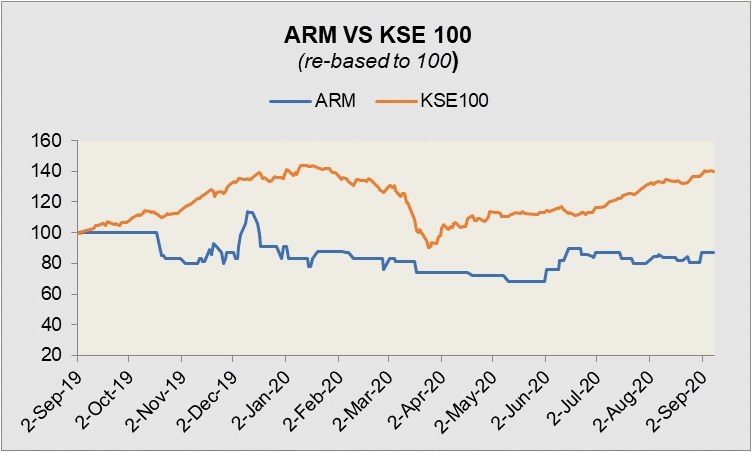Allied Rental Modaraba (PSX: ARM) started its operations in early 2007; it was formed under the Modaraba Companies and Modaraba (Floatation and Control) Ordinance, 1980. The modaraba is managed by Allied Engineering Management Company (Private) Limited. The main business of the modaraba is, as the name suggests, in the rental business; this includes power generation equipment, material handling equipment, and construction related machinery.
Shareholding pattern
The modaraba is primarily owned by the associated companies with 91 percent certificate ownership. Of this, 69 percent of the certificates are held under Allied Engineering and Services Limited. The directors, CEO, their spouses, and minor children together own around 9 percent of the certificates. Of this Mr. Khwaja Ahad Rahman, a non-executive director of the company, owns the majority within the category at nearly 3 percent.

Historical operational performance
The company’s main source of revenue is through the ijarah rentals, the share of which in the total revenue has increased over time. The company has also, for the large part, witnessed positive growth in its ijarah rentals revenue.

During FY15, the company saw a relatively subdued growth in ijarah rentals at around 6.3 percent. Most of this increase in the revenue was brought about by the Logistics and Forklift Fleet segment, whereas power generation equipment side saw a decline. This was due to unavailability of gas particularly in the north of the country where gas availability situation was worse. Textile sector is the main sources of revenue for the higher capacity segment. However, due to the slump in the textile sector, the fleet utilization level reduced as did the time utilization. Despite the nominal increase in total income, profit margins could not be lifted, rather declined significantly, due to higher labour costs in response to higher sales, increase in the minimum wages, and change in sales mix that meant high wage element.
Total income in FY16 reduced marginally by less than 1 percent. Sales from Gas Engine Rental segment nearly halved year on year due to unavailability of gas to textile units. The condition improved subsequently when LNG was made available. This allowed for some probability of growth momentum for Long Term Gas Engine Rental deals. Profit margins continued to decrease since revenue declined while operating expenses also further dented profits. The latter increased due to increase in minimum wages and “sift of rental business portfolio from larger power units to smaller units of Power and Material Handling Equipment”.

The company saw double digit growth in ijarah rentals in FY17, whereas total income crossed the Rs 3 billion mark. This was essentially attributed to diversification strategies. It also continued with its tradition of investing in all sectors of the economy. Within Rental Assets, 30 percent investment was used to expand the product line for CEPC driven Machines Rental base. The Power Rental business remained stable, as the textile sector, the main contributor to revenue for the segment, saw lower demand for Diesel and Gas units. With some decline in operating expenses as a percentage of revenue, profit margins improved.
The company saw the highest growth in ijarah rentals during FY18. The Power Rental business, although continued to face low demand from the textile sector due to better grid availability to the textiles sector, was able to achieve its targeted revenue. Cement and Housing generated significant sales and revenue for the large engines segment. The latter segment is expected to remain under pressure due to better grid availability, however, due to long term contracts, some sales can continue to be generated. Operating expenses’ share in revenue increased to almost 75 percent, due to increase in minimum wages in addition to higher demand for skilled manpower. This caused gross margins to reduce, while incline in finance costs further hurt net margin.

Growth in ijarah rentals at a little over 3 percent was relatively subdued in FY19, while income from operation and maintenance was gradually gaining traction. The reason for lower growth in revenue was the general economic slowdown in the country that led to “stagnation of new contracts as well as price increments”. Operating expenses increased again to claim 76 percent of the total revenue. A combination of factors was at play that resulted in higher operating expenses- higher price of Diesel fuel, double digit inflation and currency depreciation, while increase in minimum wages and demand for skilled manpower remained intact. Despite the rise in operating expenses, net margin only marginally reduced. This was because of higher than usual other income coming from gain on disposal of fixed assets and ijarah.
Quarterly results and future outlook
There was an overall decline in total income of almost 8 percent year on year in 9MFY20. Contribution of sales in the Machines and Cranes segment reduced year on year due to contraction of the infrastructure budgets by the government. As it is the economy was under pressure that the outbreak of Covid-19 further aggravated the situation with businesses being shut down and production plants at a halt. However, gross margin managed to increase due to decline in operating costs, primarily in travelling and conveyance, repair and maintenance and salaries and wages. The same cannot be said not net margin, as it reduced due to a significant decline in other income.

With expectations of negative growth in GDP in the post-Covid scenario, the company does foresee tough times ahead, however, the low Capital Cost Rental set up gives the company a competitive edge.






















Comments
Comments are closed.